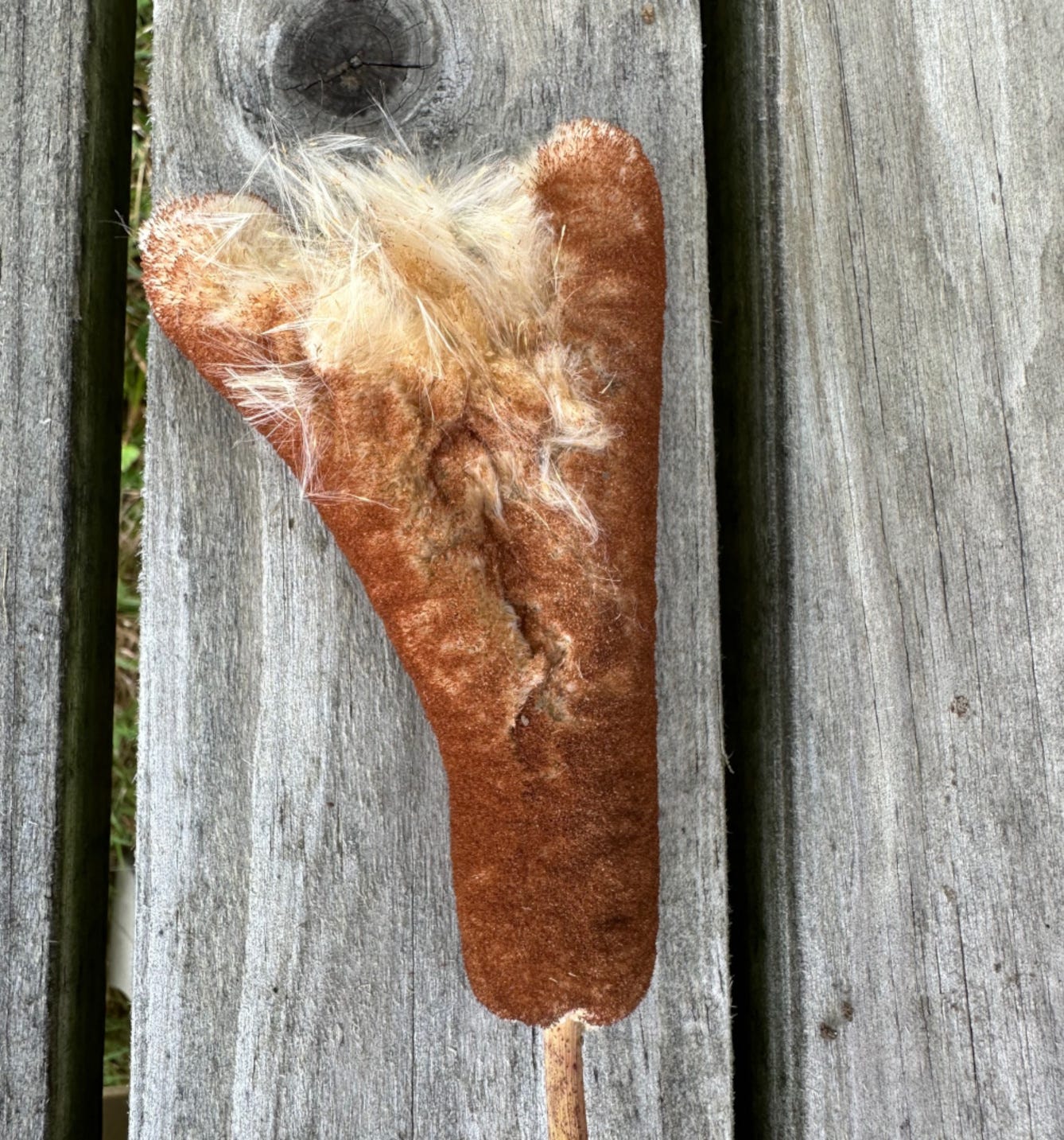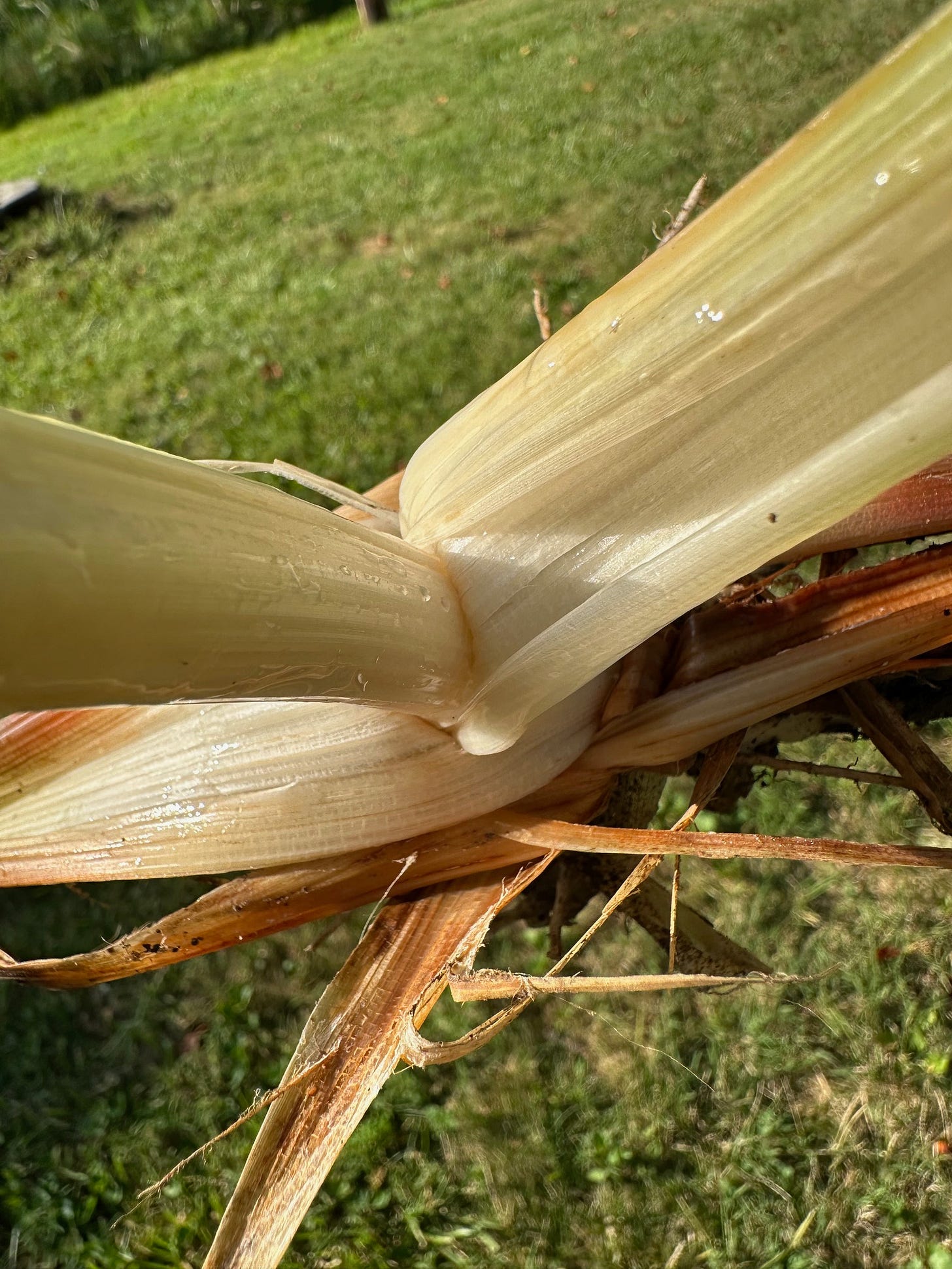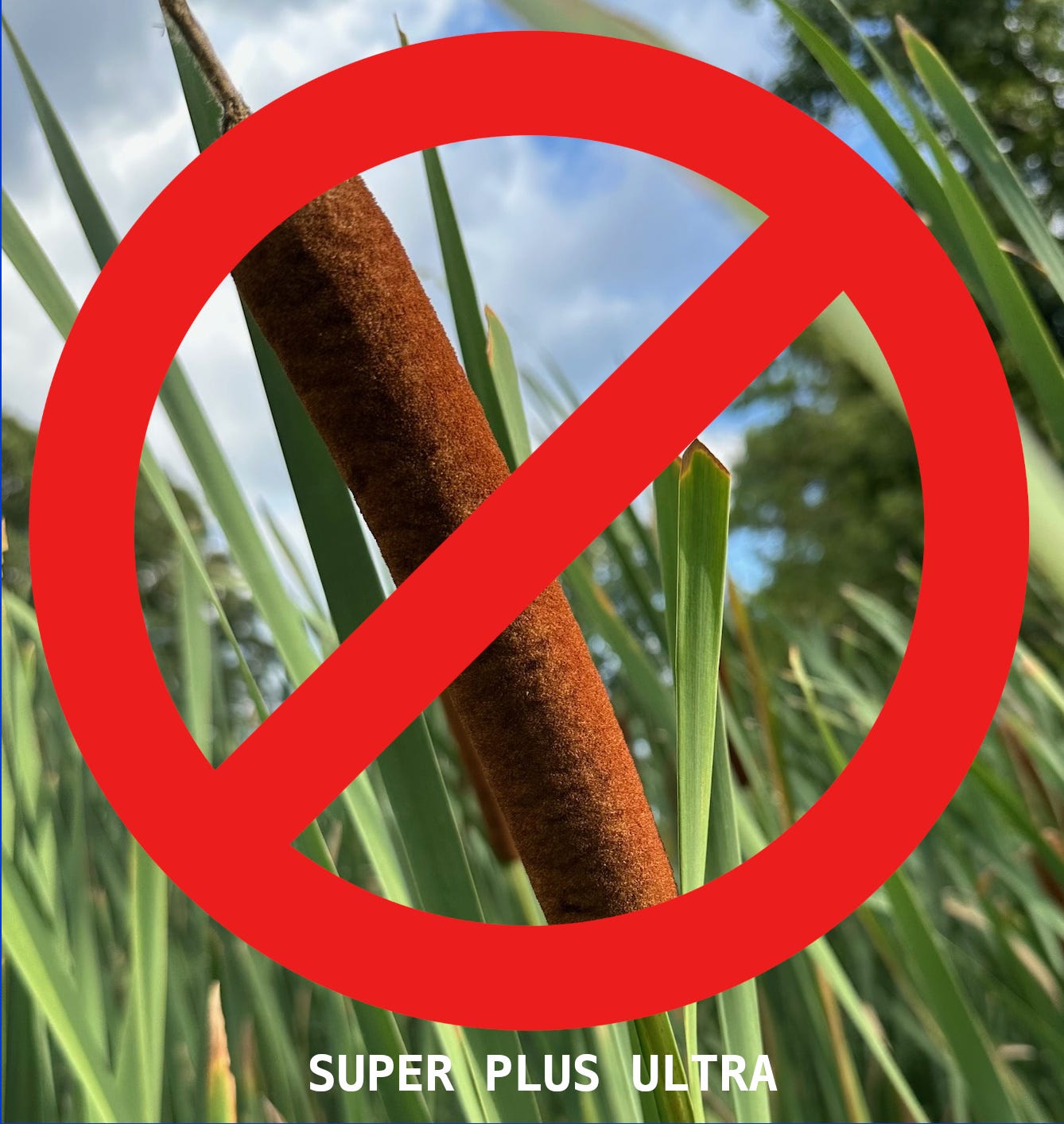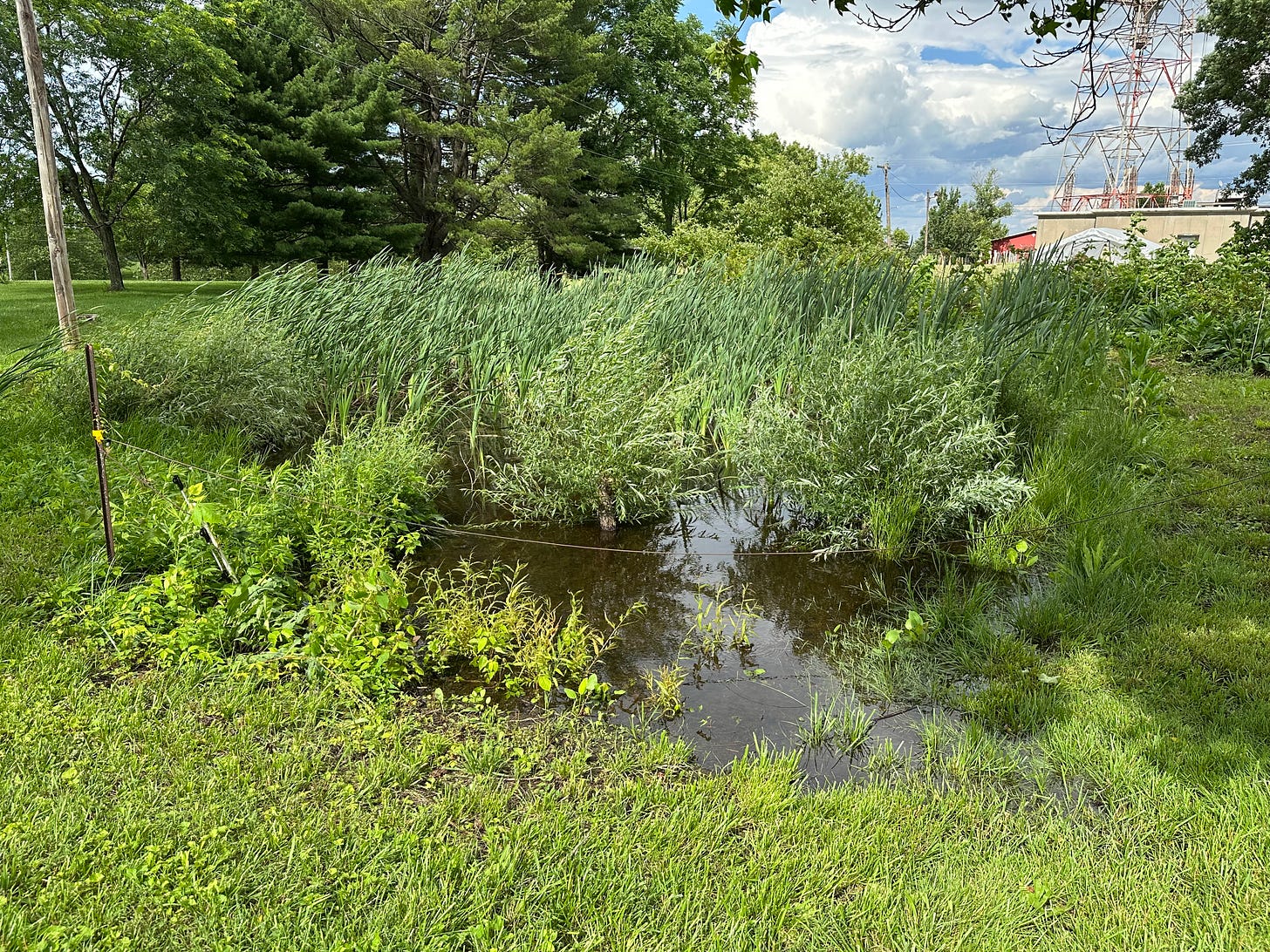Cattails 2
The industry and medicine
The last post at weedom covered usefulness of the ubiquitous cattails for various food. To this we add just a few more of the myriad industrial uses, possibilities for energy production, and some of the numerous traditional medical uses.
Cattails have been used both traditionally and on industrial scale as stuffing for mattresses, quilting, jackets and coats. People took a page from the wildlife and insulated their 'nests' with this material as well. The fluff of these sausages of the swamp, being somewhat able to entrain liquids, was used externally for diapering babies, and as feminine hygiene products. Despite the evocative shape (after trimming above and below) no way is the cattail employable as a super +++ ultra tampon for human nor beast. The 2nd pic will fully illustrate why.

For awhile during WW2, the supply of Kapok fiber (still used as natural stuffing for pillows, beds and upholstery) was cut off by Japan. So cattails were briefly used as a substitute. It was found that the “sausage” fiber was washable and retained buoyancy even when water soaked, so it was usable for lifejackets, etc. The Germans pressed cattail fibers from the leaves into sound insulating boards for construction. Though the commercial use of cattails has faded again (perhaps due to the swampy work of harvest), it remains a useful commodity. Harvest of suitable stuffing can occur from late summer to early spring, as long as the 'sausages' are intact, and a good source of clean fibers. One major caveat, if you're worried about sparks and fires, this stuffing is flammable. Maybe it’s best for non smoker households.
This brings us to torch production and fire starter. Just like using dryer lint, you can get a fire going fast with cattail fluff. Cattail ‘sausages’ can be dipped into some melted saturated fat, then lallowed to solidify, and used as a torch. It’s not super long lasting, and you would need to watch for drips, but it might serve as a short term light source, or perhaps a flaming arrow if you leave the stem attached.
In contrast, the leaves don't share such a flammability problem as the seed bearing fluff of cattails. Each leaf is divided into many longitudinal channels which add rigidity and allow the leaves to stand erect, though they are quite thin. This quality lends to their usefulness in engineered construction material which can be both load bearing and with good insulating qualities. These boards are also quite mold resistant due to the natural antimicrobial constituents in the plant material.
From the 1970s to about 2015 a lot of interest in using cattails as an alternative fuel /ethanol source was generated. This seems to have fizzled a bit. A fair amount of starch is accessible from the plants and further fermentation of cellulose could increase the efficiency. Estimates are that the ethanol yield from cattails per acre could greatly exceed that of corn, and rival or exceed that of sugar cane. Non arable land, swamps and sewage treatment areas, (even where cattails are used for remediation of contaminated land) could be utilized for this energy production instead of otherwise useful farmland. Some added processes to break down the cattails such as sonication or digestion with weak NaOH solution might be needed before a mix of such organisms as Saccharomyces and E. Coli species are utilized for the fermentation process to produce ethanol. This would solve the problem of cattail invasiveness, while simultaneously freeing up non-swamp farmland for production of food crops.
Cattails roots are known for taking up some minerals and metals quite efficiently from the water. They particularly seem to entrain iron, manganese and zinc, the latter being fairly efficient, while elements as cadmium and chromium seem to taken up more by the swamp substrate than the cattails. A main reason to choose unpolluted areas for harvesting cattails is that these plants also efficiently take up arsenic.
Older references often state that cattails contain gluten, possibly because roots could yield a somewhat sticky flour. However this is not correct.
Gluten has some smaller protein molecules called glutenins and some larger chain proteins called gliadins. The latter proteins are implicated in causing troubles for people with celiac disease.
Recent research has found that cattails, most specifically T. angustifolia (narrow leaf type) lack these gliadins, and therefore constitute a dietary option for people with celiac disease or who are otherwise intolerant of gluten.
Research in the Western world on cattails’ various uses was quite vigorous until about 2015, at which time it seeed to have dropped off precipitously. For a plant with extensive traditional medicinal use it has a surprisingly small amount of academic research efforts (in the Western world) dedicated to it. Likely this is because people have to go to the swamp in order to harvest the material. :-D
Each part of the cattail has its own array of useful medicinal qualities. For example, the constituents of the magically soothing gel that exists between the lower leaves of these plants is elusive information. Accounts abound from people collecting and using the gel to relieve skin wounds, bites, burns, etc. A few have attempted to mix this gel with oil or glycerin and to store it in the refrigerator. Most others have concluded that this gel does not preserve easily, so it’s more of a seasonal remedy to use from spring to fall. Some people report an anaesthetic effect of this gel, and compare it to oral pain relief products. I find it to be somewhat cooling, very soothing, but not strongly numbing on the skin or inside the mouth. I’d consider it the aloe gel of the North, and then some.

The Chinese, with their long history of working with the weeds, have figured out that cattail pollen works in opposing ways with respect to blood coagulation. The toasted pollen, p’u-huang, can be used to reduce bleeding externally and internally. On the other hand, raw pollen works oppositely, to break stagnation and as an anticoagulant to encourage blood flow. Raw pollen is therefore used as an emmenagogue, for example, (and therefore not for pregnant women). Various flavonoids such as quercetin and its metabolites isorhamnetin and tamarixetin exhibit antiplatelet activity, which should be borne in mind when using raw, natural products which supply large quantities of them. Cooking the cattail pollen as discussed in our prior article mitigates this effect.
The hemostatic dose of toasted pollen is from 2.5 to 9.3 grams. It can be taken as a capsule or a decoction internally, or applied externally. Naturally there’s been some interest into what causes the hemostatic effects. It seems that Pollen Typhae Carbonisatus (the formal name of the heated pollen of cattails) owes activity to the formation of compounts huaicarbon A and B which form when rutin, a.k.a. quercetin-3-O-rutinoside, is heated. Too much heating, beyond 25 min at 200 degrees centigrade, is counterproductive and degrades the huaicarbon compounds. The hemostatic compounds have been been artificially produced by combining quercetin and rhamnose sugar in 1:3 molar ratio and heating them. Sophora japonica, another well known and generous source of quercetin-3-O-rhamnoside and quercetin itself, is also a known hemostatic product. The proposed mechanisms are via enhanced intracellular accumulation of Ca++ ions, and stimulation of collagen dependent coagulation mediated by the platelet glycoprotein VI receptor. Antagonists of this GPVI receptor block the hemostatic effects of the huaicarbons A and B.
Orally available hemostatics are a rarity from big pharma. Tranexamic acid (an antifibrinolytic drug) comes to mind. When very fast hemostasis is needed under specific conditions, some extremely expensive biological products are employed intravenously. So this activity of toasted cattail pollen is of vital significance.
In Traditional Chinese Medicine, Cattails are regarded as neutral with respect to the Yin and Yang characteristics, making it fairly useful in the food category as well as as additions to various herbal formulas. It’s considered sweet and pungent and can be employed as a tonic. Western herbalism placed cattails in the cooling and drying category, and made use of the fluff of the mature seed bearing portion for stopping blood flow externally.
Lastly, I’m never tired of pounding the idea that most chronic health difficulties are due to a dietary shortage of anti-inflammatory, anti-oxidant and mucilaginous stuff from the weeds. From a medicinal study of the flour from the rhizomes of cattails, (Typha angustifolia) it seems that feeding rats this flour as 10% of their diet mitigated the inflammation and damage of the intestines from trinitrobenzenesulfonic acid induced colitis. This is basically an experimental model of inflammatory bowel disease. The cattail flour diet exhibited antiinflammatory activity and reduction of damage to the colon equal to that of prednisolone. For any person who likes bread, pancakes and crackers, a diet with 10 percent cattail flour is feasible, and preferable to taking steroids chronically.
To this end, we’ll conclude with a cattail flour recipe. It’s best to collect cattail rhizomes in the cool weather and peel them down to the cores. Cut the cores into small pieces to dry. These dried root pieces can be ground up in a flour mill, pounded or perhaps chopped in a food processor. The flour should be sifted from the fibers using a fine screen sieve or cloth bag. This dry method of producing the flour leaves a mucilaginous, gluten free product that can be added to other types of grains to make tortillas, crackers or used to thicken soups. It doesn’t behave like wheat flour, so it can’t be baked on its own too well. Sneak 1/4 to 1/3 part of cattail flour in with 3/4 to 2/3 of normal grain flour for any baking recipe, from pancakes to biscuits to breads. If you need to avoid gluten altogether, you could use corn flour and/or a light, gluten free flour mix with 1/4 part of cattail flour.
For example, to make a fluffy corn bread, devoid of gluten, combine
3/4 cup(180 ml) gluten free flour, 1/2 (120 ml) cup cattail flour, 3/4 cup corn flour (not corn meal) to make 2 cups total of flour mixture.
2/3 (160ml) cup sugar (substitute honey, etc. if desired)
2 tsp baking powder
pinch of salt
4 eggs
1 cup (240ml) milk
1/3 cup (80 ml) butter, melted
Sift all the dry ingredients together,
Beat the eggs and combine them with all wet ingredients.
Add the dry ingredients to the wet ingredients and thoroughly mix.
Pour the resultant (fairly runny) batter into a greased 8 x 4 inch bread pan.
Bake at 350 degrees F for 50 minutes to an hour, or until a toothpick poked into the center comes out clean.
You’ll get a fluffy, not stuffy bread that tastes nice and leaves sensitive intestines in a happier state.
We could write a cattail book, especially if you weigh in with your own experiences. 😎
Questions or comments? Tell us what you’re finding out there in the weeds.
Thanks to you all for hanging out at weedom.
Where We Dig
1. Allen M. Cattails Plants Against The Cold – Mother Earth News. Accessed August 18, 2025. https://www.motherearthnews.com/homesteading-and-livestock/cattail-plants-zmaz80jazraw/
2. Bax. 50 Cattail Uses and Recipes. Accessed August 18, 2025. https://www.dailysurvival.info/2025/07/50-cattail-uses-and-recipes.html
3. Bergo A. Foraging and Cooking Cattails. Forager | Chef. June 21, 2025. Accessed August 12, 2025. https://foragerchef.com/edible-cattails/
4. Demara F. Eating Cattails: An Essential (and Tasty) Foraging Skill – Mother Earth News. Accessed August 18, 2025. https://www.motherearthnews.com/real-food/eating-cattails-ze0z1211zgar/
5. Fruet AC, Seito LN, Rall VLM, Di Stasi LC. Dietary intervention with narrow-leaved cattail rhizome flour (Typha angustifolia L.) prevents intestinal inflammation in the trinitrobenzenesulphonic acid model of rat colitis. BMC Complement Altern Med. 2012;12:62. doi:10.1186/1472-6882-12-62
6. Gonnuri B, Guo L. Metal accumulation in cattails cultured in soils flooded with artificial wastewater of varying pH and different levels of metals (Cr, Cd and Zn). Int J Phytoremediation. 2024;26(14):2290-2300. doi:10.1080/15226514.2024.2389184
7. Jordan D. Eat the Weeds: A Forager’s Guide to Identifying and Harvesting 274 Wild Foods. Adventure Publications; 2023.
8. Keswani A. B^oori~Boorani Mitti |. May 21, 2017. Accessed August 12, 2025. https://sindhirasoi.com/2017/05/booriboorani-mitti/
9. Osorio CE, Mejías JH, Rustgi S. Gluten Detection Methods and Their Critical Role in Assuring Safe Diets for Celiac Patients. Nutrients. 2019;11(12):2920. doi:10.3390/nu11122920
10. Sharp JEM. The problem with cattails. Hoosier Gardener. September 16, 2017. Accessed August 11, 2025. https://hoosiergardener.com/12503/
11. Thayer S. The Forager’s Harvest - A Guide to Identifying, Harvesting, and Preparing Edible Wild Plants. Forager’s Harvest Press; 2006. https://openlibrary.org/books/OL8588402M/The_Forager's_Harvest
12. Thayer S. Sam Thayer’s Field Guide to Edible Wild Plants of Eastern & Central North America. Forager’s Harvest; 2023.
13. Yu H, Chen Y, Wu H, Wang K, Liu L, Zhang X. Synthesis of huaicarbon A/B and their activating effects on platelet glycoprotein VI receptor to mediate collagen-induced platelet aggregation. Am J Transl Res. 2017;9(2):499-506.
14. Zhou B, Tu T, Kong F, Wen J, Xu X. Revised phylogeny and historical biogeography of the cosmopolitan aquatic plant genus Typha (Typhaceae). Sci Rep. 2018;8(1):8813. doi:10.1038/s41598-018-27279-3
15. Cattail. White Rabbit Institute of Healing. Accessed August 20, 2025. https://www.whiterabbitinstituteofhealing.com/herbs/cattail/
16. Cattail - Herb Database + Images. Accessed August 20, 2025. https://earthnotes.tripod.com/cattail.htm
17. Cattail pollen - Dr. Christopher Hobbs, Ph.D. Accessed August 12, 2025. https://christopherhobbs.com/herbal-therapeutics-database/herb/cattail-pollen/
18. Cattails - Narrowleaf and Hybrid. WNY PRISM. Accessed August 11, 2025. https://www.wnyprism.org/invasive_species/cattails-narrowleaf-and-hybrid/
19. In my Iraqi Kitchen: Recipes, History and Culture, by Nawal Nasrallah. Accessed August 12, 2025. https://nawalcooking.blogspot.com/2013/03/khirret-cattailtypha-pollen-gift-of.html
20. Typha latifolia (Broadleaf Cattail, Bulrush, Cat-O’-Nine-Tails, Common Cattail) | North Carolina Extension Gardener Plant Toolbox. Accessed August 11, 2025. https://plants.ces.ncsu.edu/plants/typha-latifolia/
21. Typha latifolia Reedmace, Broadleaf cattail, Bullrush, Nailrod PFAF Plant Database. Accessed August 18, 2025. https://pfaf.org/user/plant.aspx?LatinName=Typha+latifolia
22. Content of Gluten in Rhizome of Narrow Leaved Cattail (Typha angustifolia). Zywnosc Nauka Technologia Jakosc/Food Science Technology Quality. 2010;85(1):1-13. doi:10.15193/zntj/2010/72/085-092
23. Southern Cattail. Nature Collective. April 16, 2019. Accessed August 12, 2025. https://naturecollective.org/plant-guide/details/southern-cattail/





